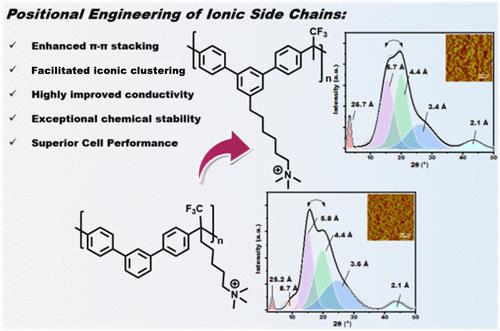离子侧链的位置工程增强了聚间terphenylene Alkylene阴离子交换膜中的π-π堆叠,以解决电导率-稳定性的权衡问题
IF 5.2
1区 化学
Q1 POLYMER SCIENCE
引用次数: 0
摘要
作为阴离子交换膜燃料电池(aemfc)和水电解槽(AEMWEs)的关键部件,阴离子交换膜(AEMs)仍然面临着碱性稳定性和离子电导率不足的重大挑战。在本研究中,聚间terphenylene alkylene离子侧链的位置工程解决了传统AEMs中长期存在的平衡电导率和稳定性的挑战。通过将季铵盐基团从脂肪节段迁移到刚性芳香terphenyl单元(P1-NTP),增强π-π堆叠促进离子团簇的有效自组装和良好连接的纳米通道。这种分子设计同时提高了氢氧化物的导电性(在80°C时为155 mS cm-1,比传统类似物高35%),减少了膨胀(12%,而对照组为24%),并具有优异的化学稳定性──在Fenton试剂中24小时保持93%的重量,在80°C的1 M NaOH中8000小时保持91%的导电性。解决的权衡实现了卓越的器件性能,AEMFC达到670 mW cm-2的峰值功率密度,AEMWE在1.88 V下达到4.00 A cm-2,工作稳定性为>; 100小时。这项工作为开发耐用和高性能的aem提供了一种可行的方法,并为结构-性能关系提供了有意义的见解。本文章由计算机程序翻译,如有差异,请以英文原文为准。

Positional Engineering of Ionic Side Chains Enhances π-π Stacking in Poly(m-Terphenylene Alkylene) Anion Exchange Membranes to Address the Conductivity-Stability Tradeoff
As critical components of anion exchange membrane fuel cells (AEMFCs) and water electrolyzers (AEMWEs), anion exchange membranes (AEMs) still face significant challenges associated with inadequate alkaline stability and ionic conductivity. In this study, the positional engineering of ionic side chains in poly(m-terphenylene alkylene) addresses the long-standing challenge of balancing conductivity and stability in conventional AEMs. By relocating quaternary ammonium groups from aliphatic segments to rigid aromatic terphenyl units (P1-NTP), enhanced π-π stacking promotes the efficient self-assembly of ionic clusters and well-connected nanochannels. This molecular design simultaneously delivers enhanced hydroxide conductivity (155 mS cm–1 at 80 °C, > 35% higher than conventional analogs), reduced swelling (12% vs 24% in controls), and excellent chemical stability─retaining > 93% weight after 24 h in Fenton’s reagent and > 91% conductivity after 8000 h in 1 M NaOH at 80 °C. The resolved tradeoff enables superior device performance, with AEMFC achieving 670 mW cm–2 peak power density and AEMWE reaching 4.00 A cm–2 at 1.88 V with > 100 h operational stability. This work presents a feasible approach to develop durable and high-performance AEMs and provides meaningful insights into the structure–property relationship.
求助全文
通过发布文献求助,成功后即可免费获取论文全文。
去求助
来源期刊

Macromolecules
工程技术-高分子科学
CiteScore
9.30
自引率
16.40%
发文量
942
审稿时长
2 months
期刊介绍:
Macromolecules publishes original, fundamental, and impactful research on all aspects of polymer science. Topics of interest include synthesis (e.g., controlled polymerizations, polymerization catalysis, post polymerization modification, new monomer structures and polymer architectures, and polymerization mechanisms/kinetics analysis); phase behavior, thermodynamics, dynamic, and ordering/disordering phenomena (e.g., self-assembly, gelation, crystallization, solution/melt/solid-state characteristics); structure and properties (e.g., mechanical and rheological properties, surface/interfacial characteristics, electronic and transport properties); new state of the art characterization (e.g., spectroscopy, scattering, microscopy, rheology), simulation (e.g., Monte Carlo, molecular dynamics, multi-scale/coarse-grained modeling), and theoretical methods. Renewable/sustainable polymers, polymer networks, responsive polymers, electro-, magneto- and opto-active macromolecules, inorganic polymers, charge-transporting polymers (ion-containing, semiconducting, and conducting), nanostructured polymers, and polymer composites are also of interest. Typical papers published in Macromolecules showcase important and innovative concepts, experimental methods/observations, and theoretical/computational approaches that demonstrate a fundamental advance in the understanding of polymers.
 求助内容:
求助内容: 应助结果提醒方式:
应助结果提醒方式:


